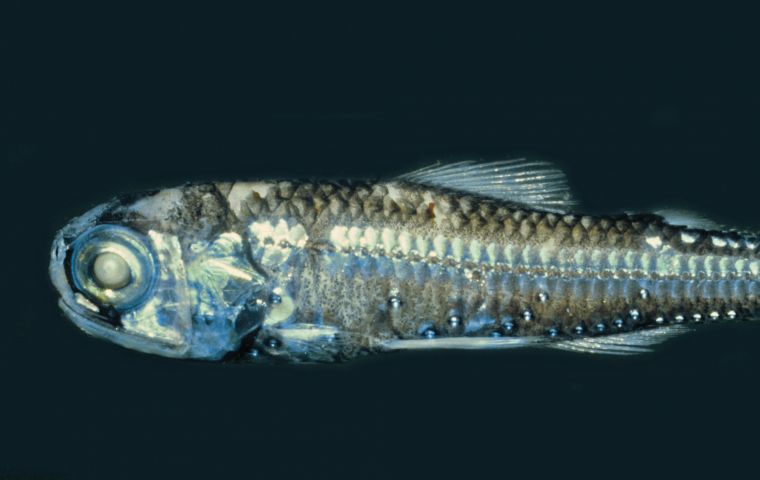MercoPress. South Atlantic News Agency
FAO report on the lanternfish in the deep Atlantic Ocean
 Lanternfish have tiny organs known as photophores, inside which a chemical reaction takes place to give off bioluminescent light
Lanternfish have tiny organs known as photophores, inside which a chemical reaction takes place to give off bioluminescent light Deep below the Atlantic Ocean’s surface, glowing objects glide through the inky black depths. On closer inspection, it is clear that they are actually a special group of fish, lanternfish, who get their name from their incredible ability to produce light.
Lanternfish have tiny organs known as photophores, inside which a chemical reaction takes place to give off bioluminescent light. These fish live in one of the largest ecosystems on earth: the mesopelagic zone of the ocean, between 200 and 1 000 meters down. Lanternfish often group together, forming dense layers. In fact, these layers contain so many fish tightly packed together that they can actually reflect sonar beams. For many years, oceanographers believed that the layers of fish were actually the ocean bottom!
This is just one misconception proving how important it is to know about the sea life inhabiting the ocean depths. By gathering knowledge on marine creatures, we can promote the sustainable use of ocean resources and protect the marine environment.
With that in mind, the FAO-implemented EAF-Nansen Program has produced a fully illustrated identification guide to mesopelagic fish of the central and southeast Atlantic Ocean. This in-depth guide details 126 lanternfish and 426 other species of fish from the mesopelagic zone. It was put together by a global team of experts, taxonomists and scientists, along with a scientific illustrator. This guide is just one part of the program’s larger research on the ocean’s resources and ecosystems.
Whilst mesopelagic fish usually inhabit between 200 and 1 000 meters below the surface of the ocean, they rise nearer to the surface shortly before sunset to feed before travelling back down again to hide from predators. Through this act they contribute to the “biological pump”, which takes carbon out of the air and brings it down to the deep ocean. This is just one of the ways in which oceans take in and store carbon dioxide from the atmosphere. Without this pump, the atmospheric concentration of CO2 would be twice its current value – so mesopelagic fish are pretty important!
Several recent studies have estimated that mesopelagic fish are the largest vertebrate group in the world in terms of biomass. This has attracted the attention of the fishing industry looking into using these resources as an alternative source of fishmeal and oils. It is therefore important to have a thorough understanding of these species to ensure that any increase in fishing is done in a sustainable way to avoid any potential adverse effects.
The necessary foundation of any research activity is accurate identification, but with mesopelagic fish this is a challenging task due to slight differences within and among species, and that their fragile bodies that are easily damaged in nets. These difficulties are what the new guide seeks to overcome.
In early 2019, the guide was put to the test by the scientists aboard the EAF-Nansen Program's research vessel, the Dr Fridtjof Nansen, during a mesopelagic fish survey off the coast of Namibia. The vessel, owned by the Norwegian Agency for Development Cooperation (Norad) and operated by FAO and Norway’s Institute of Marine Research, is unique, being the only research ship on the globe that flies the UN flag. Since 1975, the vessel has been investigating some of the planet's least-explored oceans, using cutting-edge technology to help countries assemble the scientific data critical to sustainable fisheries management.
This research survey was an opportunity to improve the identification guide based on the scientists' experience with it.
Edoardo Mostarda, FAO fisheries and biodiversity expert and scientific editor of the fish guide, explains, “The lack of tools used for identification of poorly known, yet ecologically important, fish species off the coast of West Africa hinders the work of local scientists in the efforts to manage their fisheries resources in a sustainable way. This guide is meant to fill this gap.”
After some fine-tuning, the illustrated guide was finalized and is now available online and in print for use by scientists.
Despite years of scientific research, the ocean’s vast depths still hide many secrets. For over 40 years the EAF-Nansen program. has helped identify marine resources and support sustainable development of fisheries, helping improve the food security of coastal communities and countries. Our oceans and their ecosystems might remain mysteries for decades to come, but by seeking to learn as much as we can about them, we stand a better chance of protecting them for future generations.




Top Comments
Disclaimer & comment rulesCommenting for this story is now closed.
If you have a Facebook account, become a fan and comment on our Facebook Page!